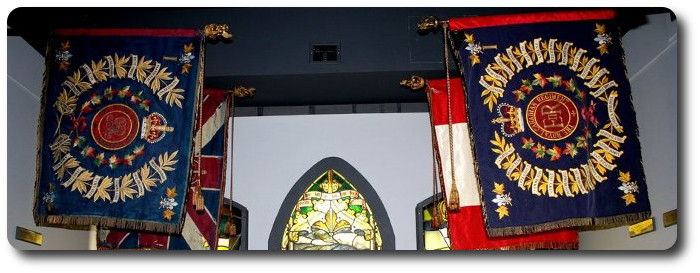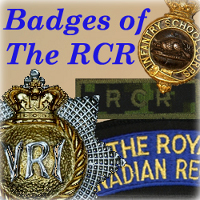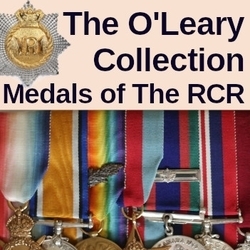
Researching The Royal Canadian Regiment
Training for Korea (Part 2)
Major S.G. (Sam) Mackness, CD
Pro Patria Issue No. 48, April 1982
Major S.G. (Sam) Mackness, CD, has provided a revealing historical glimpse at the problems encountered by The Regiment. In the December issue of Pro Patria he wrote of the formation of a training program that prepared recruits, NCOs and officers for their role in the fighting that lay ahead on the mountains and in the rice paddies of Korea.
Nippon Bara, in the heart of central Japan, was selected as an advanced weapons training center. The names of the graduates and staff have faded in memory. Major Mackness has included a few and in afterthought has asked that the likes of Phil Ash, Harry Hines, John Barrett (now BGen), Pat Austin, Bill Birch, John Bray and Vince Catalano be remembered. His story continues ..
An administration and training establishment was hastily selected from 25 CRG re-enforcement personnel. They arrived at Nippon Bara in early June 1951. Two days later, ten truckloads of supplies, tenting, bedding and training stores arrived and were dumped in the open field. It was directed that all must be ready to receive re-enforcement training groups in ten days. Stan MacDonald, who was appointed CO of the camp, proceeded to arrange the details. Sam Mackness prepared the training facilities and the training program.
Indigenous labour was hired to avoid detracting soldiers from urgent training. As usually happens under such circumstances a little baldheaded Japanese surfaced and asked in perfect English if he could be of service. He was promptly hired and soon became known to all as "Curly". In a few days this lonely area began to look like a typical Canadian Army field camp, complete with flag pole and a sentry. In ten days time the camp was ready physically, to receive two hundred re-enforcements for 2 RCR and 2 R22R.
It soon became apparent that the re-enforcements had arrived at Nippon Bara with every personnel problem one might care to name. The main one being that they had no idea of the word discipline. Absenteeism and insubordination became a serious problem. Stan MacDonald contacted 25 CRG and urgently requested some provost and medical assistance. 25 CRG was sympathetic and dispatched a medical orderly. Stan and Sam sat down to ponder the situation. This approach did not seem to be very effective. The newly acquired chief interpreter "Curly" overheard the conversation and suggested that the local Mayor, Chief of Police and local doctor might be of assistance.
The suggestion "lit a candle" and Stan requested a meeting with those Japanese officials. The Mayor authorized the Chief of Police and the local doctor to co-operate in every way. The doctor agreed to conduct daily medical parades and attend to serious injuries. The Chief of Police who still controlled the rural population with pre-war efficiency said he could locate absentees at any time. He already knew where several were now located. He also promised to control camp followers from Kure and assured their return to their own field of operation. With this support, probably unique in Canadian Army history, off duty time restrictions "in and out" of camp were abandoned as unenforceable. All ranks were paraded and informed there would be one strict rule: anyone who absented himself from duty would undergo field punishment.
Stan MacDonald was asked how he intended to apply field punishment. There were no gun wheels to tie up the offenders and field punishment had not been experienced since the South African War. Stan being a very practical officer told Sam Mackness that field punishment was still in regulations and he would have it in hand in twenty-four hours. The remains of a steel Japanese artillery training tower had been located in the area. Stan had several pieces cut into sixty pound pieces. A fifteen foot piece of rope was attached to the steel plate and the other end to the soldier's leg. The rope had an additional advantage in that the offender could continue with camp duties to a radius of fifteen feet, without carrying the plate. To the relief of the staff and full marks to Stan, the soldiers took this approach to discipline in good part. It proved the point that if under unusual circumstances discipline is fair and firm soldiers will always respond. Disciplinary cases fell to a minimum.
Unfortunately the camp cook was the first offender. The possibility of a replacement was nil. The situation was quickly overcome by lengthening the rope to allow unimpeded movement throughout the camp kitchen. It was later found to be unnecessary as the cook hired a young Japanese to carry the plate about for him. It was felt that a man with such initiative should not be discouraged.
A delegation including padres arrived from 25 CRG to check out this unusual procedure. After a day of mingling with the troops they agreed it was a practical solution to a difficult situation. They noted that morale in Camp was excellent.
Training at Nippon Bara developed to platoon and company mountain exercises with live firing support from battalion support weapons.
In September 1951 Stan MacDonald was posted back to 25 CRG as 2IC and Sam Mackness was appointed CO of the Camp. A good rapport developed between area officials and the camp staff. A phone call to area officials for advice or assistance met with immediate response by their presence at the camp office. This continued until official peace was declared between the allies and Japan. That day the mayor sent a message to the camp CO stating that he and his officials would be available in "THEIR" offices at any time. This seemed to be fair and good relations continued. Indigenous labour now numbered about one hundred, with thirty percent being female. The usual minor problems in such a situation developed. Difficulties were avoided by parading the female help each evening to be counted and escorted back to the village by a local police constable. A day care centre and infant feeding accommodation had to be set up in the camp area. A Japanese social worker was hired to conduct this operation. Grandma Sans brought the infants on their backs, to the camp three times a day.
In September 1951 reverse order training requirements again developed. An increase of infantry support weapons over-establishment was directed for 2 RCR and 2 R22R. The CO at Nippon Bara was directed to conduct a two-week training course for these weapons. A platoon scale of mortars, medium machine gun and anti tank weapons arrived at Nippon Bara, ordnance packed and in full preservation, from WW II supplies.
Col Bingham's original 1 RCR NCOs again filled the breach. Several were flown back from Korea as instructors together with three experienced support weapon officers. Lt John Barrett now Brigadier-General Barrett and Capt Phil Ash were with this group. Their experience in Korea made it possible to start training immediately. Selected soldiers from each draft were held back for two weeks to undergo support weapon training. In a short time they were effective with their battalions in Korea. Nippon Bara continued to train re-enforcements for 2 RCR and 2 R22R until March 1952. It was then considered that the backlog of training both in Canada and Japan had been overcome and the camp was closed down shortly after.
Nippon Bara was not in favour by all authorities especially the British training establishment in Japan. However, 25 CRG prevailed and we were able to train our own soldiers.
The Canadian Army is a historical example of the expertise in declaring war and training units enroute. In spite of criticism it has always been successful over the past one hundred years, mainly due to small groups of Professional instructors rising to the occasion.


